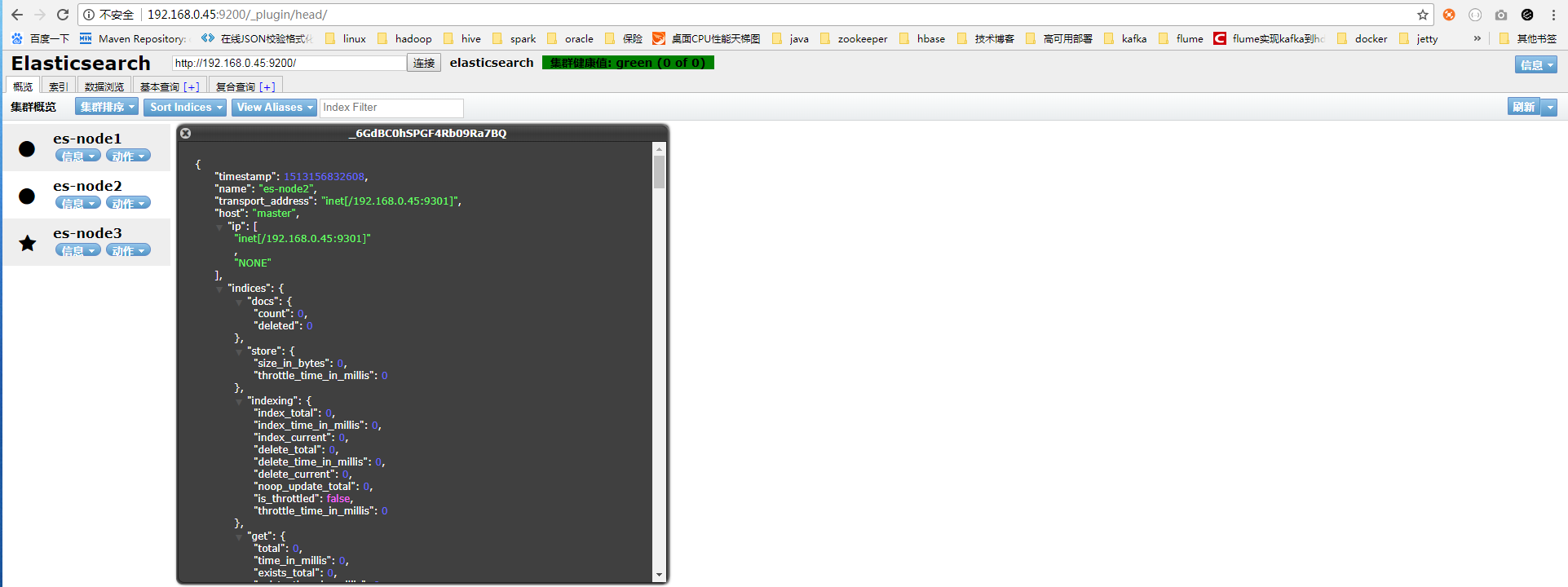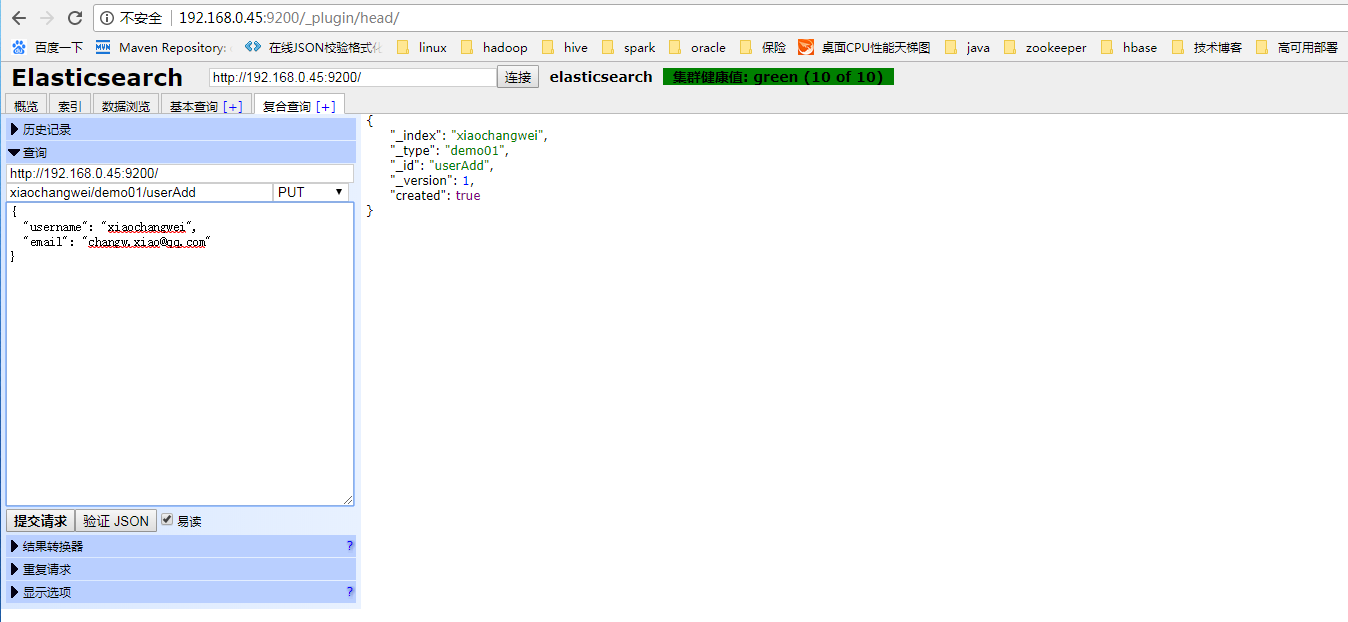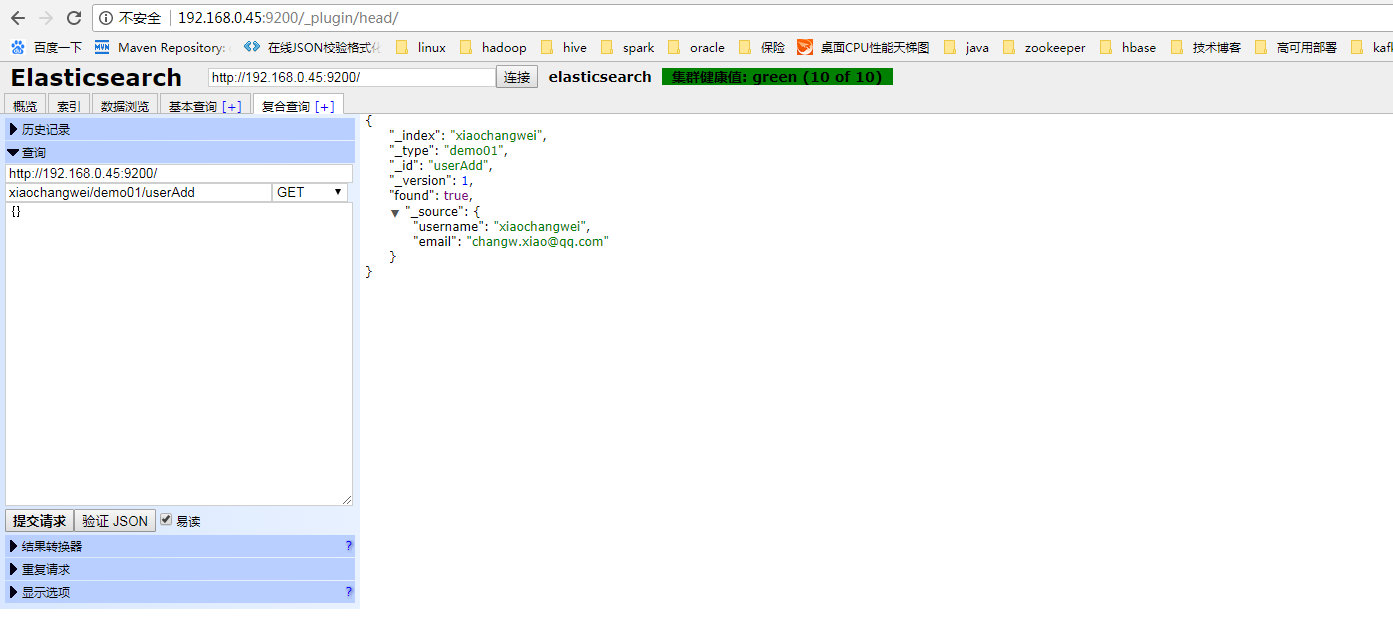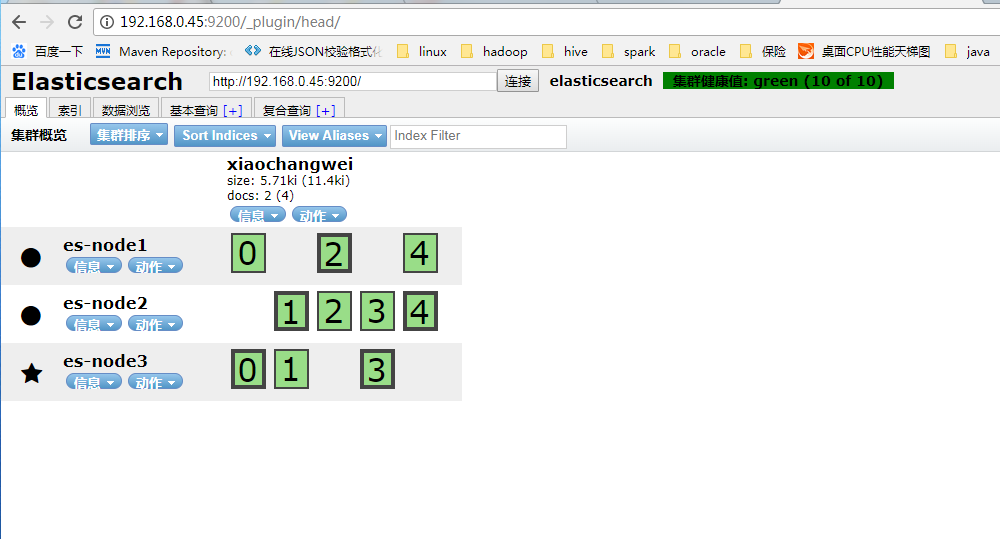CentOS下 elasticsearch集群安裝
阿新 • • 發佈:2017-12-13
pri iou per property stream removing odi cif there
1.進入root目錄並下載elasticsearch
cd /root wget https://download.elastic.co/elasticsearch/elasticsearch/elasticsearch-1.7.3.tar.gz
2.解壓下載好的壓縮包
tar -zxvf elasticsearch-1.7.3.tar.gz
3.修改目錄名字為node1(這裏需要安裝三個節點)
mv elasticsearch-1.7.3 elasticsearch-node3
4.修改/root/elasticsearch-node3/config/elasticsearch.yml 為如下內容(註意紅色部分為三個節點不一致的地方)
(下面配置未見為node3的配置)
##################### Elasticsearch Configuration Example ##################### # This file contains an overview of various configuration settings, # targeted at operations staff. Application developers should # consult the guide at <http://elasticsearch.org/guide>. # # The installation procedure is covered at #<http://elasticsearch.org/guide/en/elasticsearch/reference/current/setup.html>. # # Elasticsearch comes with reasonable defaults for most settings, # so you can try it out without bothering with configuration. # # Most of the time, these defaults are just fine for running a production # cluster. If you‘re fine-tuning your cluster, or wondering about the # effect of certain configuration option, please _do ask_ on the # mailing list or IRC channel [http://elasticsearch.org/community]. # Any element in the configuration can be replaced with environment variables # by placing them in ${...} notation. For example: # #node.rack: ${RACK_ENV_VAR} # For information on supported formats and syntax for the config file, see #<http://elasticsearch.org/guide/en/elasticsearch/reference/current/setup-configuration.html> ################################### Cluster ################################### # Cluster name identifies your cluster for auto-discovery. If you‘re running # multiple clusters on the same network, make sure you‘re using unique names. # cluster.name: elasticsearch
#集群名字, 相同集群名字的節點啟動後會自動放一起
#################################### Node ##################################### # Node names are generated dynamically on startup, so you‘re relieved # from configuring them manually. You can tie this node to a specific name: # node.name: "es-node3"
#節點名字
# Every node can be configured to allow or deny being eligible as the master, # and to allow or deny to store the data. # # Allow this node to be eligible as a master node (enabled by default): # #node.master: true # # Allow this node to store data (enabled by default): # #node.data: true # You can exploit these settings to design advanced cluster topologies. # # 1. You want this node to never become a master node, only to hold data. # This will be the "workhorse" of your cluster. # #node.master: false #node.data: true # # 2. You want this node to only serve as a master: to not store any data and # to have free resources. This will be the "coordinator" of your cluster. # #node.master: true #node.data: false # # 3. You want this node to be neither master nor data node, but # to act as a "search load balancer" (fetching data from nodes, # aggregating results, etc.) # #node.master: false #node.data: false # Use the Cluster Health API [http://localhost:9200/_cluster/health], the # Node Info API [http://localhost:9200/_nodes] or GUI tools # such as <http://www.elasticsearch.org/overview/marvel/>, # <http://github.com/karmi/elasticsearch-paramedic>, # <http://github.com/lukas-vlcek/bigdesk> and # <http://mobz.github.com/elasticsearch-head> to inspect the cluster state. # A node can have generic attributes associated with it, which can later be used # for customized shard allocation filtering, or allocation awareness. An attribute # is a simple key value pair, similar to node.key: value, here is an example: # #node.rack: rack314 # By default, multiple nodes are allowed to start from the same installation location # to disable it, set the following: #node.max_local_storage_nodes: 1 #################################### Index #################################### # You can set a number of options (such as shard/replica options, mapping # or analyzer definitions, translog settings, ...) for indices globally, # in this file. # # Note, that it makes more sense to configure index settings specifically for # a certain index, either when creating it or by using the index templates API. # # See <http://elasticsearch.org/guide/en/elasticsearch/reference/current/index-modules.html> and # <http://elasticsearch.org/guide/en/elasticsearch/reference/current/indices-create-index.html> # for more information. # Set the number of shards (splits) of an index (5 by default): # #index.number_of_shards: 5 # Set the number of replicas (additional copies) of an index (1 by default): # #index.number_of_replicas: 1 # Note, that for development on a local machine, with small indices, it usually # makes sense to "disable" the distributed features: # #index.number_of_shards: 1 #index.number_of_replicas: 0 # These settings directly affect the performance of index and search operations # in your cluster. Assuming you have enough machines to hold shards and # replicas, the rule of thumb is: # # 1. Having more *shards* enhances the _indexing_ performance and allows to # _distribute_ a big index across machines. # 2. Having more *replicas* enhances the _search_ performance and improves the # cluster _availability_. # # The "number_of_shards" is a one-time setting for an index. # # The "number_of_replicas" can be increased or decreased anytime, # by using the Index Update Settings API. # # Elasticsearch takes care about load balancing, relocating, gathering the # results from nodes, etc. Experiment with different settings to fine-tune # your setup. # Use the Index Status API (<http://localhost:9200/A/_status>) to inspect # the index status. #################################### Paths #################################### # Path to directory containing configuration (this file and logging.yml): # #path.conf: /path/to/conf # Path to directory where to store index data allocated for this node. # #path.data: /path/to/data # # Can optionally include more than one location, causing data to be striped across # the locations (a la RAID 0) on a file level, favouring locations with most free # space on creation. For example: # #path.data: /path/to/data1,/path/to/data2 # Path to temporary files: # #path.work: /path/to/work # Path to log files: # #path.logs: /path/to/logs # Path to where plugins are installed: # #path.plugins: /path/to/plugins #################################### Plugin ################################### # If a plugin listed here is not installed for current node, the node will not start. # #plugin.mandatory: mapper-attachments,lang-groovy ################################### Memory #################################### # Elasticsearch performs poorly when JVM starts swapping: you should ensure that # it _never_ swaps. # # Set this property to true to lock the memory: # #bootstrap.mlockall: true # Make sure that the ES_MIN_MEM and ES_MAX_MEM environment variables are set # to the same value, and that the machine has enough memory to allocate # for Elasticsearch, leaving enough memory for the operating system itself. # # You should also make sure that the Elasticsearch process is allowed to lock # the memory, eg. by using `ulimit -l unlimited`. ############################## Network And HTTP ############################### # Elasticsearch, by default, binds itself to the 0.0.0.0 address, and listens # on port [9200-9300] for HTTP traffic and on port [9300-9400] for node-to-node # communication. (the range means that if the port is busy, it will automatically # try the next port). # Set the bind address specifically (IPv4 or IPv6): # network.bind_host: 192.168.0.45
#綁定的ip(本機ip)
# Set the address other nodes will use to communicate with this node. If not # set, it is automatically derived. It must point to an actual IP address. # network.publish_host: 192.168.0.45
#其他節點和本節點的交互ip
# Set both ‘bind_host‘ and ‘publish_host‘: # network.host: 192.168.0.45 # Set a custom port for the node to node communication (9300 by default): # transport.tcp.port: 9302 # Enable compression for all communication between nodes (disabled by default): # #transport.tcp.compress: true # Set a custom port to listen for HTTP traffic: # http.port: 9202 # Set a custom allowed content length: # #http.max_content_length: 100mb # Disable HTTP completely: # #http.enabled: false ################################### Gateway ################################### # The gateway allows for persisting the cluster state between full cluster # restarts. Every change to the state (such as adding an index) will be stored # in the gateway, and when the cluster starts up for the first time, # it will read its state from the gateway. # There are several types of gateway implementations. For more information, see # <http://elasticsearch.org/guide/en/elasticsearch/reference/current/modules-gateway.html>. # The default gateway type is the "local" gateway (recommended): # #gateway.type: local # Settings below control how and when to start the initial recovery process on # a full cluster restart (to reuse as much local data as possible when using shared # gateway). # Allow recovery process after N nodes in a cluster are up: # #gateway.recover_after_nodes: 1 # Set the timeout to initiate the recovery process, once the N nodes # from previous setting are up (accepts time value): # #gateway.recover_after_time: 5m # Set how many nodes are expected in this cluster. Once these N nodes # are up (and recover_after_nodes is met), begin recovery process immediately # (without waiting for recover_after_time to expire): # #gateway.expected_nodes: 2 ############################# Recovery Throttling ############################# # These settings allow to control the process of shards allocation between # nodes during initial recovery, replica allocation, rebalancing, # or when adding and removing nodes. # Set the number of concurrent recoveries happening on a node: # # 1. During the initial recovery # #cluster.routing.allocation.node_initial_primaries_recoveries: 4 # # 2. During adding/removing nodes, rebalancing, etc # #cluster.routing.allocation.node_concurrent_recoveries: 2 # Set to throttle throughput when recovering (eg. 100mb, by default 20mb): # #indices.recovery.max_bytes_per_sec: 20mb # Set to limit the number of open concurrent streams when # recovering a shard from a peer: # #indices.recovery.concurrent_streams: 5 ################################## Discovery ################################## # Discovery infrastructure ensures nodes can be found within a cluster # and master node is elected. Multicast discovery is the default. # Set to ensure a node sees N other master eligible nodes to be considered # operational within the cluster. This should be set to a quorum/majority of # the master-eligible nodes in the cluster. # discovery.zen.minimum_master_nodes: 2 #最小具備master資格的節點 # Set the time to wait for ping responses from other nodes when discovering. # Set this option to a higher value on a slow or congested network # to minimize discovery failures: # discovery.zen.ping.timeout: 30s
#超時時間
# For more information, see # <http://elasticsearch.org/guide/en/elasticsearch/reference/current/modules-discovery-zen.html> # Unicast discovery allows to explicitly control which nodes will be used # to discover the cluster. It can be used when multicast is not present, # or to restrict the cluster communication-wise. # # 1. Disable multicast discovery (enabled by default): # discovery.zen.ping.multicast.enabled: false
#關閉多播發現節點
# # 2. Configure an initial list of master nodes in the cluster # to perform discovery when new nodes (master or data) are started: # discovery.zen.ping.unicast.hosts: ["192.168.0.45:9300","192.168.0.45:9301","192.168.0.45:9302"] #集群中的其他節點信息,默認端口為9300 # EC2 discovery allows to use AWS EC2 API in order to perform discovery. # # You have to install the cloud-aws plugin for enabling the EC2 discovery. # # For more information, see # <http://elasticsearch.org/guide/en/elasticsearch/reference/current/modules-discovery-ec2.html> # # See <http://elasticsearch.org/tutorials/elasticsearch-on-ec2/> # for a step-by-step tutorial. # GCE discovery allows to use Google Compute Engine API in order to perform discovery. # # You have to install the cloud-gce plugin for enabling the GCE discovery. # # For more information, see <https://github.com/elasticsearch/elasticsearch-cloud-gce>. # Azure discovery allows to use Azure API in order to perform discovery. # # You have to install the cloud-azure plugin for enabling the Azure discovery. # # For more information, see <https://github.com/elasticsearch/elasticsearch-cloud-azure>. ################################## Slow Log ################################## # Shard level query and fetch threshold logging. #index.search.slowlog.threshold.query.warn: 10s #index.search.slowlog.threshold.query.info: 5s #index.search.slowlog.threshold.query.debug: 2s #index.search.slowlog.threshold.query.trace: 500ms #index.search.slowlog.threshold.fetch.warn: 1s #index.search.slowlog.threshold.fetch.info: 800ms #index.search.slowlog.threshold.fetch.debug: 500ms #index.search.slowlog.threshold.fetch.trace: 200ms #index.indexing.slowlog.threshold.index.warn: 10s #index.indexing.slowlog.threshold.index.info: 5s #index.indexing.slowlog.threshold.index.debug: 2s #index.indexing.slowlog.threshold.index.trace: 500ms ################################## GC Logging ################################ #monitor.jvm.gc.young.warn: 1000ms #monitor.jvm.gc.young.info: 700ms #monitor.jvm.gc.young.debug: 400ms #monitor.jvm.gc.old.warn: 10s #monitor.jvm.gc.old.info: 5s #monitor.jvm.gc.old.debug: 2s ################################## Security ################################ # Uncomment if you want to enable JSONP as a valid return transport on the # http server. With this enabled, it may pose a security risk, so disabling # it unless you need it is recommended (it is disabled by default). # #http.jsonp.enable: true
5.拷貝配置好的node3目錄為node1,node2並根據步驟4修改elasticsearch.yml
cp -r elasticsearch-node3/ elasticsearch-node1
cp -r elasticsearch-node3/ elasticsearch-node2
6.修改好node1,node2的配置文件後,依次啟動
/root/elasticsearch-node1/bin/elasticsearch -d -Xms512m -Xmx512m
/root/elasticsearch-node2/bin/elasticsearch -d -Xms512m -Xmx512m
/root/elasticsearch-node3/bin/elasticsearch -d -Xms512m -Xmx512m
7.檢查啟動狀態
[root@localhost ~]# ps -ef | grep elasticsearch
root 1892 1 26 16:32 pts/0 00:00:10 /root/jdk/bin/java -Xms256m -Xmx1g -Djava.awt.headless=true -XX:+UseParNewGC -XX:+UseConcMarkSweepGC -XX:CMSInitiatingOccupancyFraction=75 -XX:+UseCMSInitiatingOccupancyOnly -XX:+HeapDumpOnOutOfMemoryError -XX:+DisableExplicitGC -Dfile.encoding=UTF-8 -Delasticsearch -Des.path.home=/root/elasticsearch-node1 -cp :/root/elasticsearch-node1/lib/elasticsearch-1.7.3.jar:/root/elasticsearch-node1/lib/*:/root/elasticsearch-node1/lib/sigar/* -Xms512m -Xmx512m org.elasticsearch.bootstrap.Elasticsearch
root 1913 1 21 16:32 pts/0 00:00:07 /root/jdk/bin/java -Xms256m -Xmx1g -Djava.awt.headless=true -XX:+UseParNewGC -XX:+UseConcMarkSweepGC -XX:CMSInitiatingOccupancyFraction=75 -XX:+UseCMSInitiatingOccupancyOnly -XX:+HeapDumpOnOutOfMemoryError -XX:+DisableExplicitGC -Dfile.encoding=UTF-8 -Delasticsearch -Des.path.home=/root/elasticsearch-node2 -cp :/root/elasticsearch-node2/lib/elasticsearch-1.7.3.jar:/root/elasticsearch-node2/lib/*:/root/elasticsearch-node2/lib/sigar/* -Xms512m -Xmx512m org.elasticsearch.bootstrap.Elasticsearch
root 1952 1 28 16:32 pts/0 00:00:07 /root/jdk/bin/java -Xms256m -Xmx1g -Djava.awt.headless=true -XX:+UseParNewGC -XX:+UseConcMarkSweepGC -XX:CMSInitiatingOccupancyFraction=75 -XX:+UseCMSInitiatingOccupancyOnly -XX:+HeapDumpOnOutOfMemoryError -XX:+DisableExplicitGC -Dfile.encoding=UTF-8 -Delasticsearch -Des.path.home=/root/elasticsearch-node3 -cp :/root/elasticsearch-node3/lib/elasticsearch-1.7.3.jar:/root/elasticsearch-node3/lib/*:/root/elasticsearch-node3/lib/sigar/* -Xms512m -Xmx512m org.elasticsearch.bootstrap.Elasticsearch
root 2007 1150 0 16:33 pts/0 00:00:00 grep --color=auto elasticsearch
[root@localhost ~]#
8.集群的停止:可以通過如下命令關閉集群所有節點
curl -XPOST http://192.168.0.45:9200/_cluster/nodes/_shutdown
9. 安裝可視化插件
BigDesk Plugin : 對集群中es狀態進行監控。
Elasticsearch Head Plugin: 對ES進行各種操作,如查詢、刪除、瀏覽索引等
cd /root/elasticsearch-node1/bin
./plugin -install mobz/elasticsearch-head
./plugin -install lukas-vlcek/bigdesk
10.打開瀏覽器,輸入地址 http://192.168.0.45:9200/_plugin/head/

可以看見節點信息以及相關的操作
通過頁面添加

通過get方式獲取

再返回首頁查看

更多命令請參考使用指南
後續會在springboot+springCloud系列學習內容中依次展示主流工具的使用
如 redis,mongodb等
CentOS下 elasticsearch集群安裝
